Who Said Size Doesn't Matter? The gigantic ships, striking in their dimensions, are built according to the latest technology and carry more than 90% of the total cargo by sea (and this is not counting people). The largest ships in the world include oil tankers, container ships and cruise ships.
Large ships are built for different human needs. Some, with large diesel engines, carry cargo over long distances, and naval vessels usually sail on nuclear engines so that they can not depend on fuel and stay at sea for many months. But, regardless of the method of movement, at one glance at one of the mega-ships, you understand how much human effort and what kind of engineering genius was required to build each giant.
Here list of the largest ships in the world with photo and detailed description.
10. Planet Solar - 31 meters
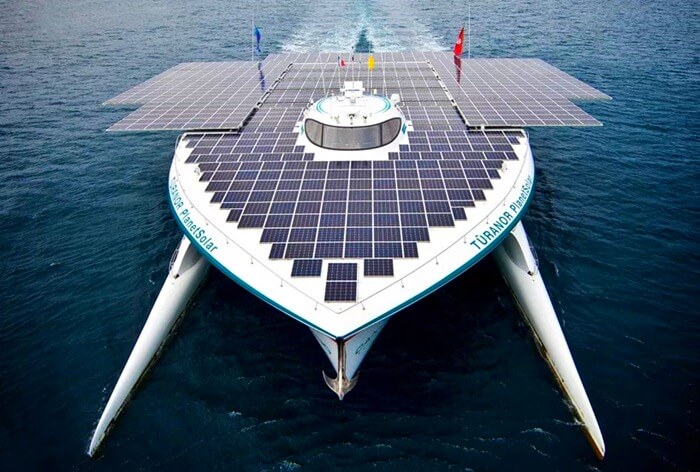 What types of energy did the shipping industry try to use - diesel, gas, nuclear, wind energy. But the solar region remained uncovered until the advent of Planet Solar. It is the largest solar powered ship in the world. Its length is 31 meters, and the panels are capable of absorbing almost 103.4 kW of solar energy.
What types of energy did the shipping industry try to use - diesel, gas, nuclear, wind energy. But the solar region remained uncovered until the advent of Planet Solar. It is the largest solar powered ship in the world. Its length is 31 meters, and the panels are capable of absorbing almost 103.4 kW of solar energy.
The ship's speed is still low - only 8 knots, but, in the end, this is a unique development. It will surely be improved.
9. Club Med 2 - 194 meters
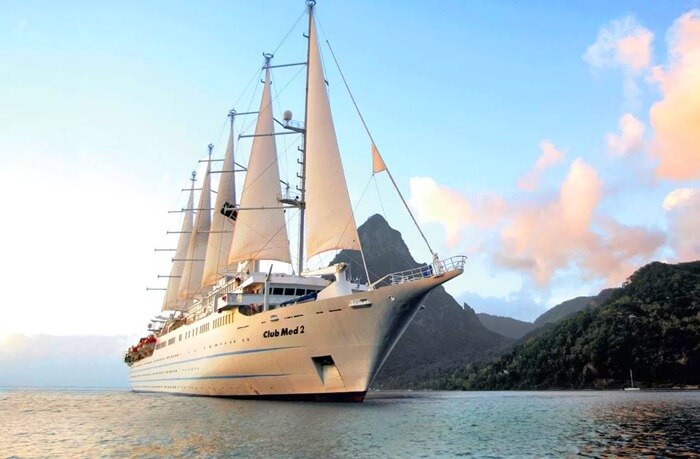 Built in 1992 in Le Havre, France, the Club Med 2 is the largest sailing ship in the world. Its length is 194 m, and its carrying capacity is 14 983 tons. For comparison: wing length the largest aircraft in the world is 117.3 meters.
Built in 1992 in Le Havre, France, the Club Med 2 is the largest sailing ship in the world. Its length is 194 m, and its carrying capacity is 14 983 tons. For comparison: wing length the largest aircraft in the world is 117.3 meters.
In addition to the 214 crew, Club Med 2 can carry 386 passengers. The sailboat develops a speed of up to 10-15 knots and currently operates as a cruise ship - in the summer it floats in the waters of the Mediterranean and Adriatic seas, and in winter it moves to the Caribbean.
Club Med 2 has five masts. In addition to seven sails (they are not controlled by people, but by the ship's computer), the ship has four diesel engines. Passenger entertainment includes ballroom dancing, card games, music shows and, of course, stunning sea views - Club Med 2 floats, like many sailing ships before it, along the coastline and only during the day, and anchors at night.
8.SSV-33 - 265 meters
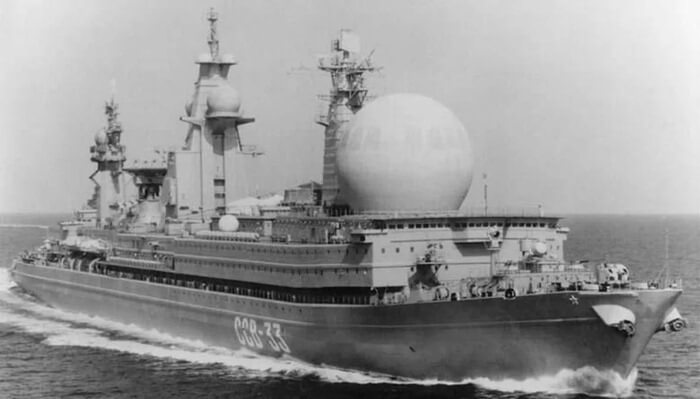 The largest ship in Russia is also known under the name "Ural". It belongs to the class of nuclear-powered reconnaissance ships. The Ural was built during the Cold War, when the USSR and the United States watched each other with might and main. And it was intended for intelligence operations in the largest ocean in the world, where the United States had several ballistic missile test sites. The length of the "Ural" was 265 meters, the crew consisted of 950 people, the cruising speed was 21.6 knots. Thanks to the nuclear engine, the Ural was autonomous and after refueling could not enter the port for three months.
The largest ship in Russia is also known under the name "Ural". It belongs to the class of nuclear-powered reconnaissance ships. The Ural was built during the Cold War, when the USSR and the United States watched each other with might and main. And it was intended for intelligence operations in the largest ocean in the world, where the United States had several ballistic missile test sites. The length of the "Ural" was 265 meters, the crew consisted of 950 people, the cruising speed was 21.6 knots. Thanks to the nuclear engine, the Ural was autonomous and after refueling could not enter the port for three months.
The Ural began its service on the Far East coast, where, due to its gigantic size, there was no pier of a suitable size for it, so the ship spent most of its time at anchor in the bay.But his calmness was deceptive - in the 80s "Ural" served as the main source of information about what is happening in the military circles of the United States and Japan.
It all ended with the beginning of perestroika. First, junior conscripts were transferred to the reserve, then nuclear boilers were damaged as a result of the fire. For a while, the ship lived on diesel generators, until the painful half-starved existence ended in 2001 - the Ural was put on hold. Its disposal began in 2008, and by 2016 it was finally dismantled.
7.USS Enterprise (CVN-65) - 342 meters
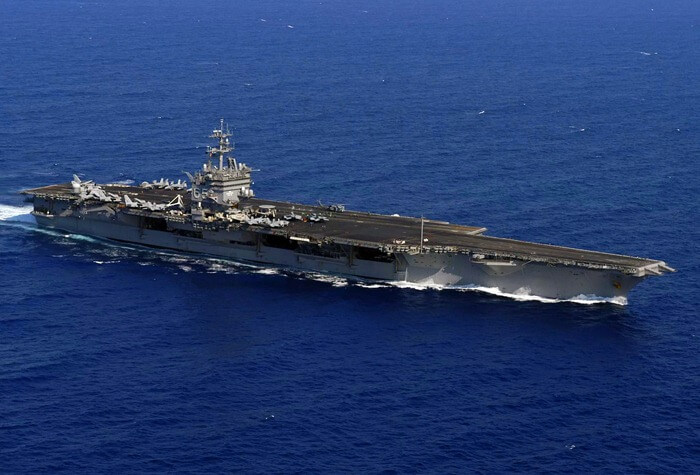 No, this ship has nothing to do with Star Trek, but its size is truly impressive - it is the largest warship in the world in the history of the navy. Its length is 342 meters, it can carry up to 4,600 troops, 2,520 tons of weapons, and the cruise speed of the Enterprise's namesake is 33.6 knots.
No, this ship has nothing to do with Star Trek, but its size is truly impressive - it is the largest warship in the world in the history of the navy. Its length is 342 meters, it can carry up to 4,600 troops, 2,520 tons of weapons, and the cruise speed of the Enterprise's namesake is 33.6 knots.
USS Enterprise has a long and illustrious history.
- Once it became the first among nuclear aircraft carriers (launched in 1961) and its price was so high that it was decided to abandon the planned series of ships of the same purpose and size.
- He began serving USS Enterprise during the Cuban Missile Crisis, then patrolled the Mediterranean, participated in the Vietnam War and, almost twenty years later, in Iraq, fought sea pirates ...
- Overall, it had a 51 straight year of service - longer than any other US aircraft carrier to this day.
But the world was changing, and even such a technically perfect ship, regularly undergoing modernization, is hopelessly outdated. In 2012, the ship made its last voyage. And by April 2018, he was finally out of action.
6.RMS Queen Mary 2 - 345 meters
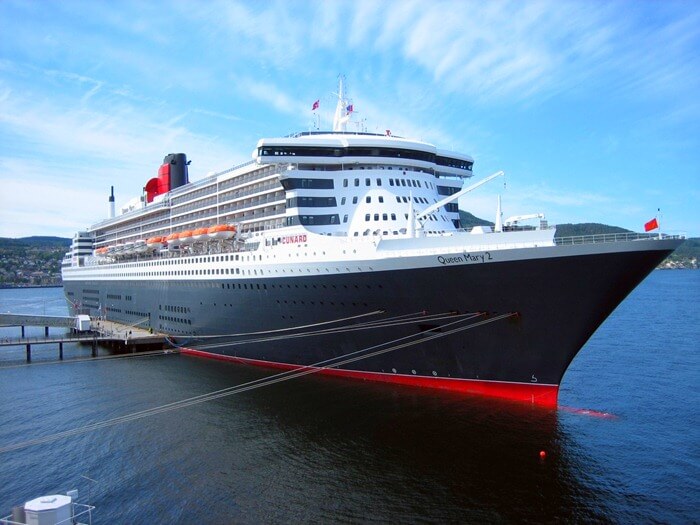 The world's largest transatlantic liner is the RMS Queen Mary 2, built in 2004. The ship got its name in honor of the first "Queen Mary", which left the shipyard in 1936, and the abbreviation RMS (royal mail ship) was awarded only to the fastest and most reliable ships. The RMS Queen Mary 2 is currently the only transatlantic vessel cruising between Southampton and New York. However, once a year, the "Queen" also works as a cruise ship, making a round-the-world tour.
The world's largest transatlantic liner is the RMS Queen Mary 2, built in 2004. The ship got its name in honor of the first "Queen Mary", which left the shipyard in 1936, and the abbreviation RMS (royal mail ship) was awarded only to the fastest and most reliable ships. The RMS Queen Mary 2 is currently the only transatlantic vessel cruising between Southampton and New York. However, once a year, the "Queen" also works as a cruise ship, making a round-the-world tour.
The Queen Mary is 345 meters long and can accommodate 2,620 passengers and 1,253 crew members. She develops a speed of 30 knots. Although the ship is inferior in size to titanic cruise liners (however, by only 15 meters), it still does not give up its position as the largest ocean liner.
- A cruise liner differs from an ocean liner in that the first of them goes on a journey and drops passengers on the spot in the same port, while the purpose of the second is to transport passengers from one point to another.
- However, this is not the only difference. The transatlantic liner makes long journeys, therefore, it often encounters adverse weather conditions. Therefore, its design should be stronger than that of cruise liners sailing in comfortable conditions, seaworthiness - better, and engines - more powerful.
- A cruise ship can afford to focus on the number of passengers carried instead of seaworthiness and endurance - that's why they have such a funny box shape for better passenger capacity.
5. Gas carriers Q-Max - 345 meters
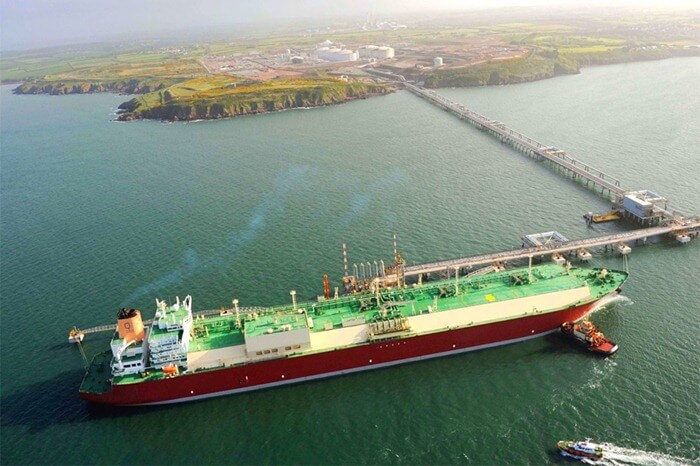 The world's largest carriers of liquefied gas are Q-Max vessels. Their length reaches 345 m, and their total capacity varies from 262,000 to 267,000 m3. At the same time, their speed is not bad for ships of this class - 19.5 knots.
The world's largest carriers of liquefied gas are Q-Max vessels. Their length reaches 345 m, and their total capacity varies from 262,000 to 267,000 m3. At the same time, their speed is not bad for ships of this class - 19.5 knots.
Currently there are 14 vessels of this type in circulation; they were built by Samsung, Hyundai and Daewoo. The very first of them, Mozah, left the shipyard in 2007 and got its name in honor of one of the wives of the Emir of Qatar. All 14 vessels are owned by a Qatari natural gas carrier. These are the largest ships that can dock at LNG terminals.
4. Oasis of the Seas - 360 meters
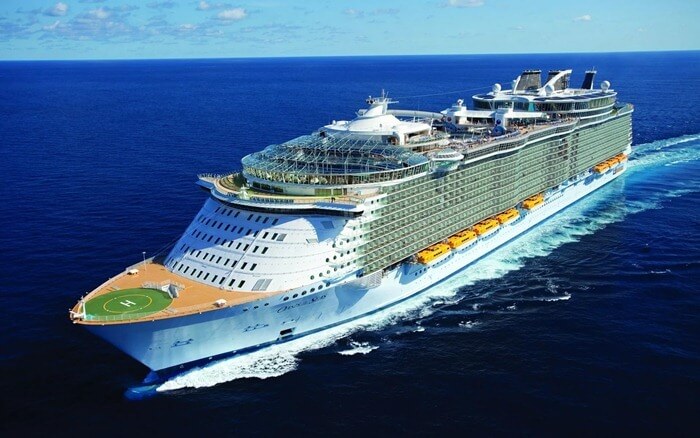 The largest passenger ships in the world are the Oasis of the Seas, Allure of the Seas, and Harmony of the Seas, formerly known as Project Genesis. They are owned by Royal Caribbean and were built in 2009, 2010 and 2015, respectively.The length of the cruise ships is 360 m and the capacity is up to 6,296 passengers, excluding the crew of 2,394. These are the fastest large passenger ships at a speed of 22.6 knots.
The largest passenger ships in the world are the Oasis of the Seas, Allure of the Seas, and Harmony of the Seas, formerly known as Project Genesis. They are owned by Royal Caribbean and were built in 2009, 2010 and 2015, respectively.The length of the cruise ships is 360 m and the capacity is up to 6,296 passengers, excluding the crew of 2,394. These are the fastest large passenger ships at a speed of 22.6 knots.
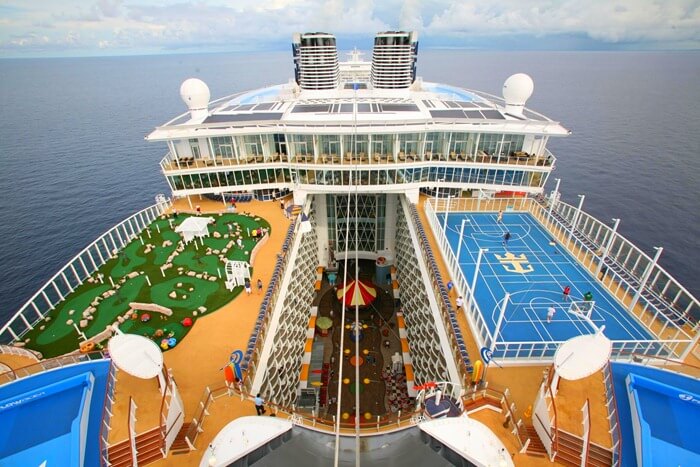 There is plenty of entertainment on board so that tourists on board do not get bored. There is even surfing, a zipline (downhill) 25 m long and 9 decks high, two 13 m high climbing walls, swimming pools, a basketball court, a water park and even an ice rink. No wonder there are so many maintenance personnel on the ship!
There is plenty of entertainment on board so that tourists on board do not get bored. There is even surfing, a zipline (downhill) 25 m long and 9 decks high, two 13 m high climbing walls, swimming pools, a basketball court, a water park and even an ice rink. No wonder there are so many maintenance personnel on the ship!
The cost to build the Oasis of the Seas was around $ 1.14 million, the highest price ever paid for a civilian ship in human history. Both Oasis and Allure currently operate weeklong Caribbean cruises and are very popular with tourists.
3. TI class ships - 380 meters
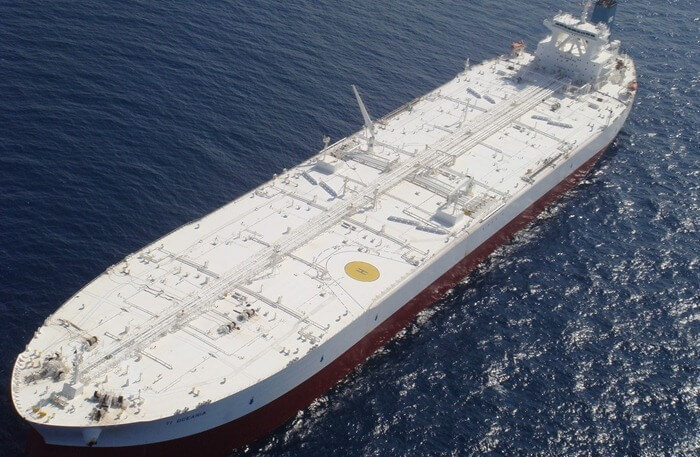 The largest oil tankers in service were designed and built for the Hellespont Group at a shipyard in South Korea by Daewoo (or rather its shipbuilding division) in 2003. There are four vessels in total - later the customers renamed them to TI Oceania, TI Europe, TI Asia and TI Africa.
The largest oil tankers in service were designed and built for the Hellespont Group at a shipyard in South Korea by Daewoo (or rather its shipbuilding division) in 2003. There are four vessels in total - later the customers renamed them to TI Oceania, TI Europe, TI Asia and TI Africa.
Approximately $ 90 million and 700,000 man-hours were spent on the construction of each vessel. They are shorter than the Knock Nevis at 78 m; their length is 380 m, their carrying capacity is 440,000 tons, and they can reach speeds from 16 to 18 knots. In addition to their size, the ships impress with their graceful outlines and beauty of design; if you look at them from high above, most of all they look like giant snow-white icebergs.
2. CSCL Globe and Maersk Triple E class vessels - 400 meters
 In the fall of 2014, the christening ceremony of the world's largest container ship, the CSCL Globe, took place. It was the very first of five 19,000 TEU (TEU - "20-foot equivalent", a measure of the carrying capacity) ordered by a Chinese shipbuilding company in 2013. True, since then, the CSCL Globe record has been broken by OOCL class freighters, whose capacity reaches an impressive 21,413 TEU - for the same length.
In the fall of 2014, the christening ceremony of the world's largest container ship, the CSCL Globe, took place. It was the very first of five 19,000 TEU (TEU - "20-foot equivalent", a measure of the carrying capacity) ordered by a Chinese shipbuilding company in 2013. True, since then, the CSCL Globe record has been broken by OOCL class freighters, whose capacity reaches an impressive 21,413 TEU - for the same length.
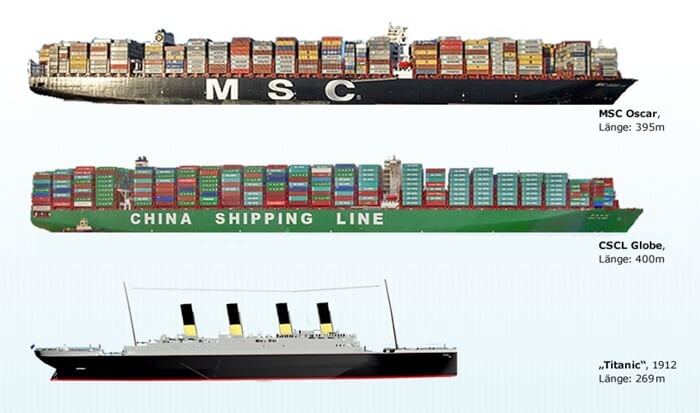 The mega-ship with a length of 400 m sails with the help of the main engine with a capacity of 77,200 hp. with., the efficiency of which is so high that it consumes no more fuel than a container ship with a carrying capacity of almost half. Fuel savings are up to 20%. This is due to the fact that the "smart" engine reacts to the situation at sea and accordingly adjusts the fuel consumption.
The mega-ship with a length of 400 m sails with the help of the main engine with a capacity of 77,200 hp. with., the efficiency of which is so high that it consumes no more fuel than a container ship with a carrying capacity of almost half. Fuel savings are up to 20%. This is due to the fact that the "smart" engine reacts to the situation at sea and accordingly adjusts the fuel consumption.
The Danish company Maersk ordered the construction of 20 Maersk Triple E class vessels from Daewoo. Each of them cost about $ 200 million. Their capacity is slightly less than that of the CSCL Globe (18,000 TEU), but they are almost the same in length. The cruising speed of the new container ships is high - from 23 to 26 knots, which makes them the fastest ships of this class in the world.
Triple E, that is, "triple E" - encoded in a short form, the principles adhered to by customers and shipbuilders:
- saving;
- energy efficiency;
- environmental friendliness.
Maersk ships are currently among the most cost-effective container ships in terms of cost / volume of cargo transported.
1. Knock Nevis - 458.45 meters
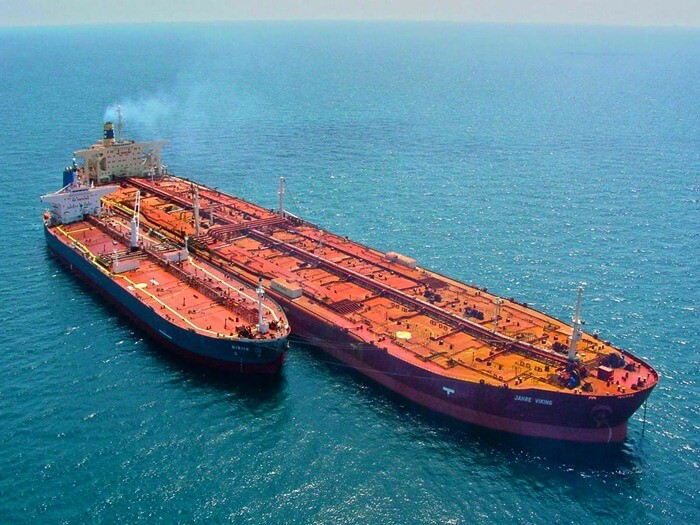 During its service to the people, the ship changed many names - Seawise Giant, Happy Giant, Jahre Viking and, finally, Knock Nevis. It is the longest ship in the history of shipbuilding - from bow to stern, it is 1504 feet (or 458.45 m) in length, which is longer than the length of the Empire State Building, laid on its side. Knock Nevis belonged to the ULCC class of oil tankers and had the largest carrying capacity of all ships. It is considered the largest man-made object that can move independently of all that has ever been built by man.
During its service to the people, the ship changed many names - Seawise Giant, Happy Giant, Jahre Viking and, finally, Knock Nevis. It is the longest ship in the history of shipbuilding - from bow to stern, it is 1504 feet (or 458.45 m) in length, which is longer than the length of the Empire State Building, laid on its side. Knock Nevis belonged to the ULCC class of oil tankers and had the largest carrying capacity of all ships. It is considered the largest man-made object that can move independently of all that has ever been built by man.
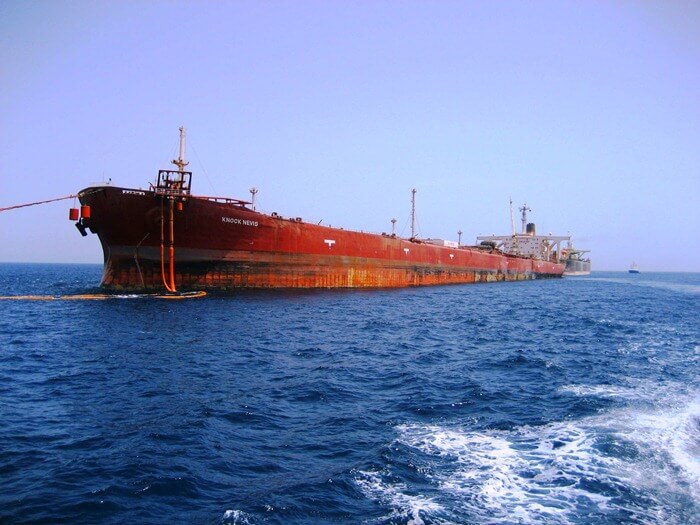 At full load, the volume of cargo transported by the ship was 657,019 tons, and with a draft of 24.6 m, even the English Channel, Suez and Panama Canals were shallow for the sea giant. The ship's speed was surprisingly high for this size - 16 knots. The Knock Nevis was powered by a single engine with a diameter of 9 m. The stopping distance from cruising speed to full stop was 9 km, and the turning radius of the vessel was 3 km. Served by his team of 35 people.
At full load, the volume of cargo transported by the ship was 657,019 tons, and with a draft of 24.6 m, even the English Channel, Suez and Panama Canals were shallow for the sea giant. The ship's speed was surprisingly high for this size - 16 knots. The Knock Nevis was powered by a single engine with a diameter of 9 m. The stopping distance from cruising speed to full stop was 9 km, and the turning radius of the vessel was 3 km. Served by his team of 35 people.
Knock Nevis was built in 1979 by the Japanese shipbuilding company Sumimoto Heavy Industries at the Japanese shipyard in Yokosuko. The Greek owner named the ship "Porthos".Since then, the ship has seen a lot:
- traveled the seas for about 30 years;
- was damaged in 1988 during the Iran-Iraq war;
- was renovated and sold to Norway;
- in 2009 he made his last trip to a shipyard in Gujarat, India, where he was dismantled.
Why are the largest ships in the world dangerous?
Huge ships are not very environmentally friendly. Carriage of goods by sea costs the planet almost 1.4 billion tons of carbon dioxide, which is 6% of the total emissions. This number is twice that of air transport.
For this reason, most sea giants are trying to convert to highly efficient and fuel-saving engines, and also use hybrid systems - there are ships that are powered by wind and solar energy.

